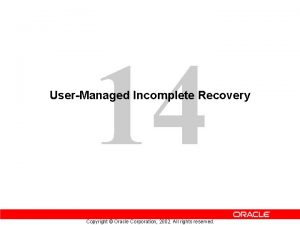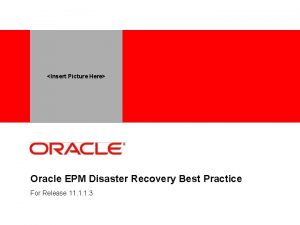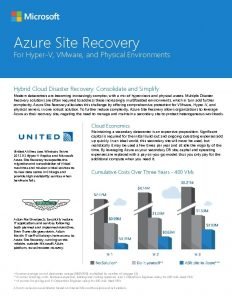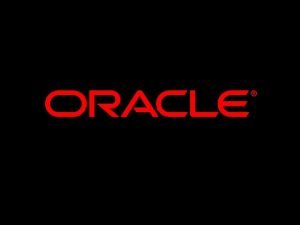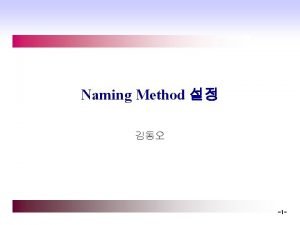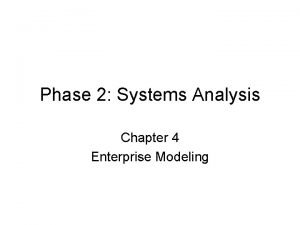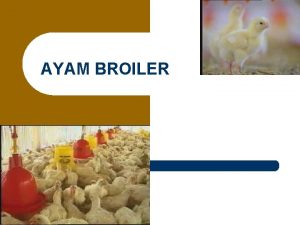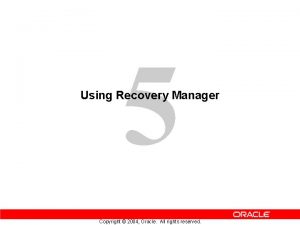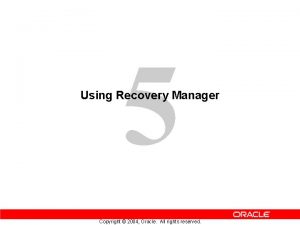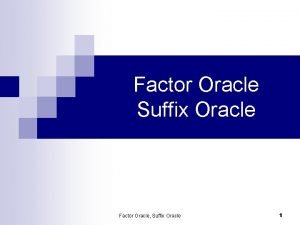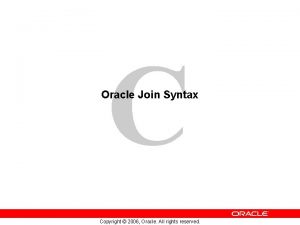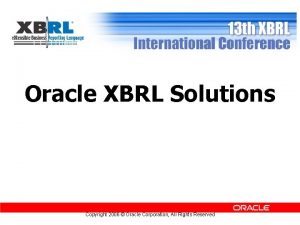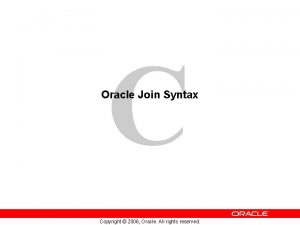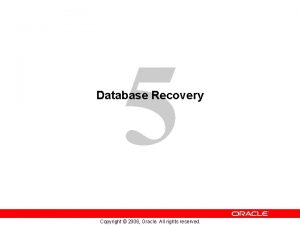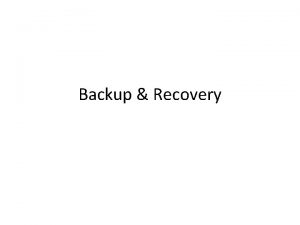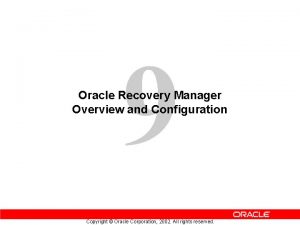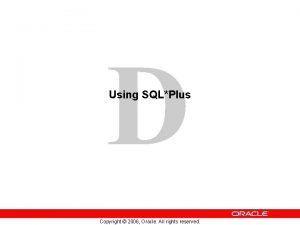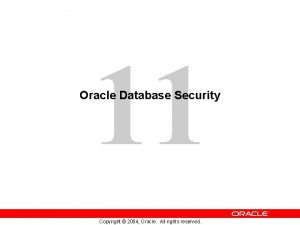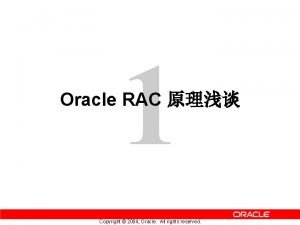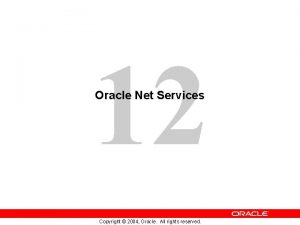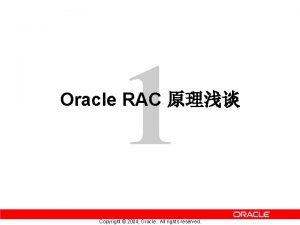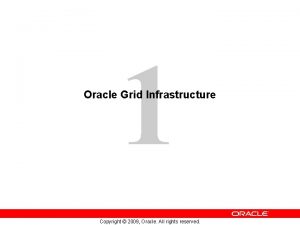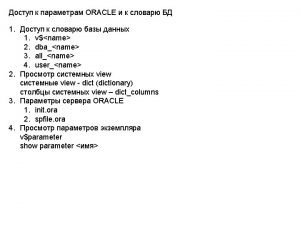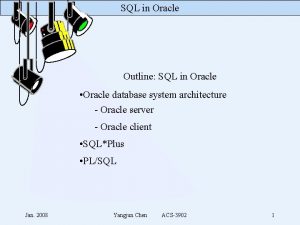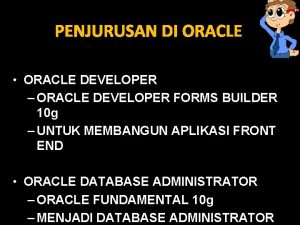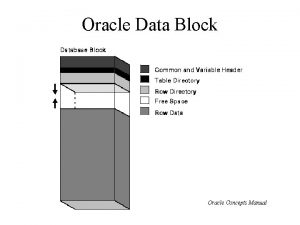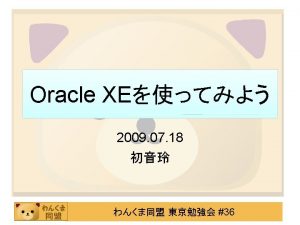3 Using Recovery Manager Copyright 2006 Oracle All






























- Slides: 30

3 Using Recovery Manager Copyright © 2006, Oracle. All rights reserved.

Objectives Commands BACKUP Block C. T. Inc. Update LIST REPORT DELETE After completing this lesson, you should be able to do the following: • Use the RMAN BACKUP command to create backup sets and image copies • Manage the backups and image copies taken with RMAN 3 -2 Copyright © 2006, Oracle. All rights reserved.

Issuing Recovery Manager Commands • Interactive client – Enter commands at RMAN prompt. – Use when performing analysis, or when running reports or stored scripts. • Batch mode – Use with automated jobs. – Specify a command file when starting RMAN. – Specify the log file name to capture session log. • Pipe interface – Specify the PIPE command-line argument. – Use to communicate data between sessions or between RMAN and an external application. 3 -3 Copyright © 2006, Oracle. All rights reserved.

Types of RMAN Commands RMAN commands are of the following types: • Stand-alone command: – Is executed individually at the RMAN prompt – Cannot appear as subcommands within RUN • Job command: – Must be within the braces of a RUN command – Is executed as a group Some commands can be executed as either a stand-alone or a job command. 3 -5 Copyright © 2006, Oracle. All rights reserved.

Job Commands: Example Job commands appear inside a RUN command block: RMAN> 2> 3> 4> 5> 6> 7> 3 -6 RUN { BACKUP AS BACKUPSET FORMAT '/u 01/db 01/backup/%d_%s_%p' DURATION 10: 00 MINIMIZE LOAD (DATABASE); SQL 'alter system archive log current'; } Copyright © 2006, Oracle. All rights reserved.

RMAN Commands: Overview RESTORE RECOVER FLASHBACK SPFILE Target database Control file Archived log files 3 -7 Enterprise Manager RMAN BACKUP Stored scripts Catalog maintenance CROSSCHECK DELETE…EXPIRED CHANGE Copyright © 2006, Oracle. All rights reserved. REPORT LIST Catalog database

BACKUP Command RMAN> BACKUP AS BACKUPSET 2> FORMAT '/BACKUP/df_%d_%s_%p. bus' 3> TABLESPACE hr_data; 3 -9 Data file 1 Data file 2 Data file 3 Tablespace HR_DATA Backup set Copyright © 2006, Oracle. All rights reserved. Commands > BACKUP Block C. T. Inc. Update LIST REPORT DELETE

Backup Constraints • • 3 -10 The database must be mounted or open. You cannot back up online redo logs. Only “clean” backups are usable in NOARCHIVELOG mode. Only “current” data file backups are usable in ARCHIVELOG mode. Copyright © 2006, Oracle. All rights reserved.

Parallelization of Backup Sets For performance, allocate multiple channels and assign files to specific channels. Data file 1 Data file 4 Data file 5 Channel MML Data file 2 Data file 3 Data file 9 Channel MML Data file 6 Data file 7 Data file 8 Backup piece 2 Channel MML 3 -11 Backup piece 1 Copyright © 2006, Oracle. All rights reserved. Backup Piece 3

Compressed Backups RMAN> BACKUP AS 2> COMPRESSED BACKUPSET 3> DATABASE; Database files RMAN> 2> 3> 4> 3 -13 CONFIGURE DEVICE TYPE DISK PARALLELISM 2 BACKUP TYPE TO COMPRESSED BACKUPSET; Copyright © 2006, Oracle. All rights reserved. Compressed backup files

Image Copy RMAN> 2> 3> RMAN> 4> 5> BACKUP AS COPY DATAFILE '/ORADATA/users_01_db 01. dbf' FORMAT '/BACKUP/users 01. dbf'; BACKUP AS COPY ARCHIVELOG LIKE 'arch_1060. arc' FORMAT 'arch_1060. bak'; Copy of data file 3 Data file 3 Copy of archived log Archived log file 3 -14 Archived log file Copyright © 2006, Oracle. All rights reserved.

Tags for Backups and Image Copies A tag is a logical name assigned to a backup set or image copy. 3 -16 month_full_backup week_full_backup Data files 1, 3 Data files 2, 4 Data file 4 Backup set Copyright © 2006, Oracle. All rights reserved.

BACKUP Command Options • • 3 -17 Check for physical block corruptions. Scan for logical corruptions and physical corruptions. Set a threshold on the number of detected corruptions allowed before aborting. Validate the target input files before performing a backup operation. Duplex the backup set. Overwrite an existing backup set or image copy. Pass control of the data transfer between storage devices and the data files on disk to the media management layer. Encrypt the backup files. Copyright © 2006, Oracle. All rights reserved.

Backing Up Archived Redo Logs • • Online redo log file switch is automatic. Archived log failover is performed. You can specify a range of archived redo logs to back up. Backup sets of archived redo log files cannot contain any other type of file. RMAN> BACKUP 2> FORMAT '/disk 1/backup/ar_%t_%s_%p' 3> ARCHIVELOG FROM SEQUENCE=234 4> DELETE INPUT; 3 -19 Copyright © 2006, Oracle. All rights reserved.

Whole Database Backup RMAN> BACKUP DATABASE PLUS ARCHIVELOG; Archived log file copies 3 -21 Data file copies Control file Copyright © 2006, Oracle. All rights reserved. SPFILE

RMAN Backup Types • • 3 -22 A full backup contains all used data file blocks. A level 0 incremental backup is equivalent to a full backup that has been marked as level 0. A cumulative level 1 incremental backup contains only blocks modified since the last level 0 incremental backup. A differential level 1 incremental backup contains only blocks modified since the last incremental backup. Full, or "level 0 incremental backup" Cumulative incremental backup Differential incremental backup Copyright © 2006, Oracle. All rights reserved.

Differential Versus Cumulative • • A differential incremental backup contains all blocks changed since the last incremental backup. A cumulative incremental backup contains all blocks changed since the last level 0 incremental backup. Level 0 Lvl 0 Day Sun 3 -24 Level 0 1 1 1 c 1 Mon Tue Wed Thu Copyright © 2006, Oracle. All rights reserved. 1 c Fri 1 0 Sat Sun

Block Change Tracking Commands BACKUP > Block C. T. Inc. Update LIST REPORT DELETE The backup process can be streamlined by enabling block change tracking, which: • Records changed blocks in a change tracking file • Is used automatically by RMAN, if enabled • Optimizes incremental backups by avoiding full data file scans during backup List of changed blocks CTWR SGA 3 -25 Redo generation 1011001010110 0001110100101 1010101110011 Copyright © 2006, Oracle. All rights reserved. Change tracking file Redo log

Enabling Block Change Tracking SQL> 2> 3> 4> 3 -26 ALTER DATABASE ENABLE BLOCK CHANGE TRACKING USING FILE '/mydir/rman_change_track. f' REUSE; Copyright © 2006, Oracle. All rights reserved.

Incrementally Updating Backups Image copy of data file Incremental backup files RMAN> RECOVER COPY OF 2> DATAFILE {n|'file_name'} 3> WITH TAG 'incr_upd_df 1'; Image copy of data file updated to a more recent state Recovered data file 3 -27 Copyright © 2006, Oracle. All rights reserved. Commands BACKUP Block C. T. > Inc. Update LIST REPORT DELETE

LIST Command • List backup sets and copies of data files: Commands BACKUP Block C. T. Inc. Update > LIST REPORT DELETE RMAN> LIST BACKUP OF DATABASE; RMAN> LIST BACKUP OF DATAFILE 2> "/db 01/ORADATA/u 03/users 01. dbf"; • List backup sets and copies of any data file for a specified tablespace: RMAN> LIST COPY OF TABLESPACE "SYSTEM"; • List backup sets and copies containing archive logs for a specified range: RMAN> LIST COPY OF DATABASE ARCHIVELOG 2> FROM TIME='SYSDATE-7'; 3 -28 Copyright © 2006, Oracle. All rights reserved.

REPORT Command • • Produces a detailed analysis of the repository Produces reports to answer: – What are the data files in the database? – Which files need a backup? – Which backups can be deleted? – Which files are unrecoverable? 3 -29 Copyright © 2006, Oracle. All rights reserved. Commands BACKUP Block C. T. Inc. Update LIST > REPORT DELETE

REPORT NEED BACKUP Command • • • Lists all data files that require a backup Assumes that the most recent backup is used during a restore Provides four options: – – • 3 -30 Incremental Days Redundancy Recovery window Uses the current retention policy configuration if no options are specified Copyright © 2006, Oracle. All rights reserved.

REPORT NEED BACKUP: Examples • Files that need more than three incremental backups for recovery: RMAN> REPORT NEED BACKUP incremental 3; • Files that have not been backed up for three days: RMAN> REPORT NEED BACKUP days 3; • Backup needed if there are not two or more backups already: RMAN> REPORT NEED BACKUP redundancy 2; • Backup needed to recover to three days ago: RMAN> REPORT NEED BACKUP 2> recovery window of 3 days; 3 -31 Copyright © 2006, Oracle. All rights reserved.

REPORT OBSOLETE and DELETE OBSOLETE • Commands BACKUP Block C. T. Inc. Update LIST REPORT > DELETE Find all recovery files that are deemed obsolete according to the current retention policy settings: RMAN> REPORT OBSOLETE; • List the obsolete recovery files, if no more than two backup copies are needed: RMAN> REPORT OBSOLETE REDUNDANCY 2; • Delete the backup set with a backup set key of 4: RMAN> DELETE BACKUPSET 4; • Delete the recovery files considered obsolete, because they have more than two backups: RMAN> DELETE OBSOLETE REDUNDANCY 2; 3 -32 Copyright © 2006, Oracle. All rights reserved.

Managing Backups with EM Navigation aid: Database home page > Maintenance > Manage Current Backups 3 -33 Copyright © 2006, Oracle. All rights reserved.

RMAN Dynamic Views • • • 3 -34 V$ARCHIVED_LOG V$BACKUP_CORRUPTION V$BACKUP_DEVICE V$BACKUP_FILES V$BACKUP_PIECE V$BACKUP_REDOLOG V$BACKUP_SET V$BACKUP_SPFILE V$COPY_CORRUPTION V$RMAN_CONFIGURATION Copyright © 2006, Oracle. All rights reserved.

Monitoring RMAN Backups • • 3 -36 Correlate server sessions with channels by using the SET COMMAND ID command. Query V$PROCESS and V$SESSION to determine which sessions correspond to which RMAN channels. Query V$SESSION_LONGOPS to monitor the progress of backups and copies. Use an operating system utility to monitor the process or threads. Copyright © 2006, Oracle. All rights reserved.

Summary In this lesson, you should have learned how to: • Use the RMAN BACKUP command to create backup sets and image copies • List backups and image copies taken with RMAN • Report and delete obsolete RMAN backups 3 -38 Copyright © 2006, Oracle. All rights reserved.

Practice Overview: Backing Up Your Database This practice covers the following topics: • Enabling archival of redo logs for a database • Using RMAN to display the database structure • Using Recovery Manager to back up data files and the control file • Using Recovery Manager to make image copies of data files • Creating a compressed backup of a database • Scheduling a backup job 3 -39 Copyright © 2006, Oracle. All rights reserved.
 Copyright 2006
Copyright 2006 Copyright 2006
Copyright 2006 Oracle disaster recovery plan
Oracle disaster recovery plan Incomplete recovery in oracle
Incomplete recovery in oracle Oracle ebs disaster recovery plan
Oracle ebs disaster recovery plan Manageengine recovery manager plus
Manageengine recovery manager plus Windows azure hyper v recovery manager
Windows azure hyper v recovery manager Acronis startup recovery manager
Acronis startup recovery manager Recovery manager
Recovery manager Name three line segments
Name three line segments Wim coekaerts
Wim coekaerts Oracle workspace manager
Oracle workspace manager Oracle net manager
Oracle net manager Senior manager vs general manager
Senior manager vs general manager Portfolio manager synergy manager parental developer
Portfolio manager synergy manager parental developer Copyright 2015 all rights reserved
Copyright 2015 all rights reserved Copyright 2015 all rights reserved
Copyright 2015 all rights reserved Dell all rights reserved copyright 2009
Dell all rights reserved copyright 2009 Copyright © 2018 all rights reserved
Copyright © 2018 all rights reserved Using system.collections
Using system.collections Accumulator ac
Accumulator ac Dfd symbols are referenced by using all
Dfd symbols are referenced by using all Dfd chapter 5
Dfd chapter 5 Using a single marketing strategy to reach all customers.
Using a single marketing strategy to reach all customers. Help ever hurt never
Help ever hurt never Interventi sociali rivolti all'infanzia e all'adolescenza
Interventi sociali rivolti all'infanzia e all'adolescenza Above all powers above all kings
Above all powers above all kings I work all night i work all day to pay the bills
I work all night i work all day to pay the bills All to one reduction
All to one reduction Sistem all in all out
Sistem all in all out Mesothenar
Mesothenar



